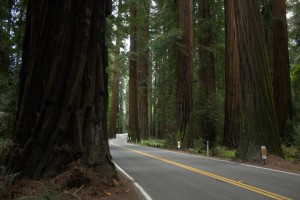|
RICHARDSON GROVE REDWOODS:
H Richardson Grove State Park in southern Humboldt County, is one of the state’s oldest state parks and and is one of the last protected stands of old-growth redwood trees in the world. The park has essential habitat for protected species, and its creeks support runs of imperiled salmon and steelhead trout, in addition to being a revered and popular camping area, called “the gateway to the redwoods”. The state transportation agency Caltrans seeks to widen and straighten the curvy Hwy 101 through the ancient redwoods of this 99-year old State Park to provide access for more and bigger trucks through the redwoods. This is one of those issues it seems we have won over and over, and yet…here we are. In order to “realign the roadway”, Caltrans intends to cut into and pave over the root systems of thousand-year-old trees, which, if it does not kill trees outright will almost certainly weaken them, cause canopy dieback, and shorten the lifespan of these irreplaceable ancient redwoods. Since Caltrans first proposed this boondoggle project in 2007, there has been strong opposition and numerous legal challenges, all with favorable decisions for the environmental groups. But Caltrans persists in re-proposing the project, time after time. Now, new research published in 2021 has documented how cutting and paving over the roots of old-growth redwoods causes long-term harms to coast redwood forests. Researchers with the California Dept. of Forestry and two Universities found that road construction significantly harmed adjacent old-growth at HRS Park, causing growth suppression, elevated water stress, and crown dieback of redwoods. This study and other evidence was submitted to Caltrans but the agency has chosen to ignore that evidence. The recent Caltrans approval of the project violates CEQA, the California Environmental Quality Act, a state law requiring public agencies to evaluate and disclose the environmental impacts of a project and to limit or avoid those impacts to the extent feasible. Caltrans failed to prepare an environmental impact report for the project, did not evaluate significant impacts, did not adopt effective mitigation measures, and failed to circulate a valid environmental review document for public comment. Each prior consideration of this unnecessary road widening project has been halted by successful legal actions, brought forward by our legal champions the Center for Biological Diversity and EPIC, the Environmental Protection Information Center and others. Caltrans then changes a few words and resurrects their proposal. Despite being held up in court for over a decade, the agency refuses to see that it was ill-conceived from the beginning. The irony is that this risky project is unnecessary since Caltrans has already implemented exemptions that allow some oversized trucks to currently drive through the grove. In response, conservation groups and Humboldt residents filed a legal challenge on March 7, 2023, to this fourth attempt by Caltrans to approve the controversial Richardson Grove Project. The Center for Biological Diversity, EPIC, Californians for Alternatives to Toxics, Friends of Del Norte, and several individual Humboldt residents with generational family ties to Richardson Grove filed the action. We hope this will be heard in court soon and put a stop for good to this threat to ancient redwoods. We will let you know if there is public action you can take, other than making your opinions known to Caltrans, which is always appropriate. ::<>::<>::<>::<>::<>::<>::<>::<>::<>::<>::<>::<>::<>::<>::<>::<>::<>:: MEDICINE LAKE THREATENED WITH SALVAGE LOGGING
Refuge to wolves and many other threatened and sensitive species, Medicine Lake forests threatened with clearcutting. The Medicine Lake Highlands, northeast of Mt. Shasta, are threatened with 20,000 acres of clearcutting, although the Klamath National Forest calls it “fire recovery” and “fuels reduction”. The environmental assessment (EA) for the Antelope Tennant timber sale was recently released and is open for public comment. Rather than address the significant impacts and public controversy with “salvage” logging, the Forest Service is pushing through this inadequate analysis by calling it an emergency, even though the fires were in 2021. The Antelope Tennant project would disturb fragile post-fire forests with clearcut logging of snags and also surviving green trees. In addition, it proposes to clearcut nearly 5,000 acres of older green lodgepole pine stands in the name of “sanitation” and “regeneration”. The project also includes 8 miles of road construction and thousands of acres of “ripping” the forest floor. Despite the fact that these forests are home to threatened and endangered species, there is zero information provided. This area is home to the Whaleback Pack, one of only three known Gray wolf activity areas in California. The Medicine Lake Highlands are also home to Pronghorn antelope, bald eagle, Northern goshawk, great gray owl, marten, and fisher, and yet reports have not been completed and no information has been provided to the public. The EA does not contain adequate site-specific information and there are no supporting reports. The Medicine Lake Highlands encompass California’s most diverse volcanic fields on the continent’s largest shield volcano and is one of the most unique geological areasin the country. The Highlands are also the ancestral territory of multiple Indigenous Tribes, significant to many Native peoples including the Pit River Nation, Modoc, Shasta, Karuk and Wintu. Big thanks to EPIC for providing the information contained on this issue. |


 ere we go again: Same ill-conceived project, same clueless agency, same beneficiaries (the trucking industry and big box stores)
ere we go again: Same ill-conceived project, same clueless agency, same beneficiaries (the trucking industry and big box stores)
